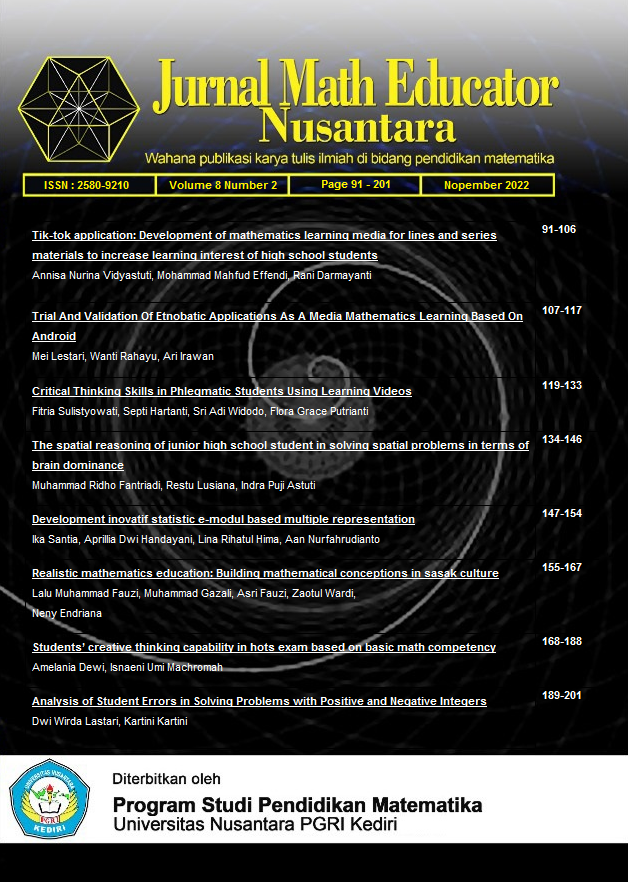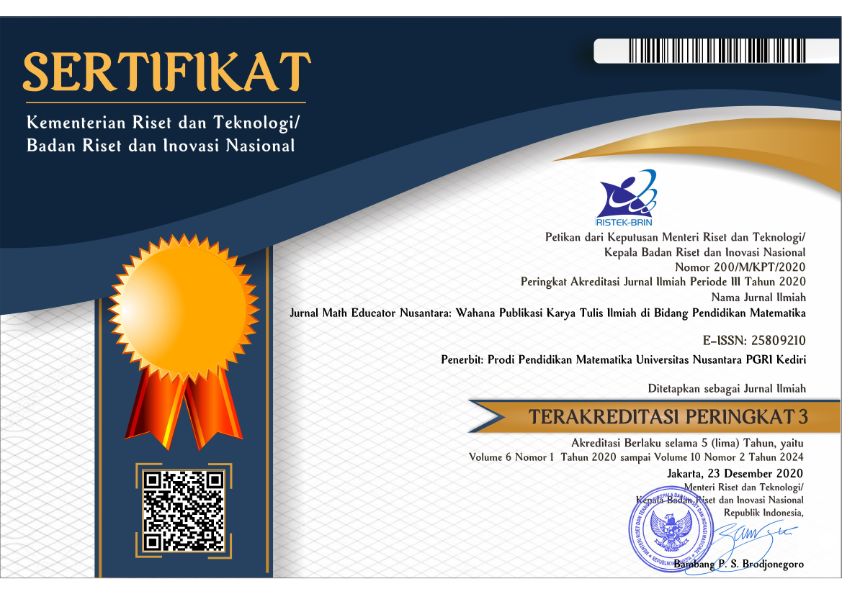Students’ creative thinking capability in hots exam based on basic math competency
DOI:
https://doi.org/10.29407/jmen.v8i2.17779Keywords:
Creative thinking capability, HOTS, Basic math competencyAbstract
Creative thinking capability is one’s ability to solve problems by having several solutions (fluency), using various methods (flexibility), and finding different and unusual solution with correct answer (novelty). Numerous researches have been done about student’s creative thinking capability in solving math problems. However, it is only a small fraction that studies the capability on solving HOTS problems. This research is descriptive-qualitative research, with 6 8th grade class G of SMP Negeri 8 Purwokerto as subjects. The material used in this study is a system of two-variable linear equations. Data are gathered using documentation, test, and interview techniques. To analyze the data, this research used data reduction, presentation, and conclusion, while also using triangulation methods. The result of this research shows that: 1) Students with high competency in basic math meet the level of HOTS and achieved all three indicators of creative thinking fluency, flexibility, and novelty; 2) Students with moderate competency meet the level of HOTS and achieved two indicators which are fluency and flexibility; 3) Students with low competency in basic math meet the level of HOTSand could only achieve one out of three indicators of creative thinking that is fluency.
References
Achir, Y. S., Usodo, B., & Retiawan, R. (2017). Analisis Kemampuan Komunikasi Matematis Siswa Dalam Pemecahan Masalah Matematika Pada Materi Sistem Persamaan Linear Dua Variabel (Spldv) Ditinjau Dari Gaya Kognitif. Paedagogia, 20(1), 78. https://doi.org/10.20961/paedagogia.v20i1.16600
Adi La. (2022). Pendidikan keluarga dalam perpekstif islam. Jurnal Pendidikan Ar-Rashid, 7(1), 1–9.
Agustina, L. R., & Khotimah, R. P. (2018). Kesalahan dalam Menyelesaikan Soal Bentuk Aljabar Tipe Higher Order Thinking Skills (HOTS). Konfrrensi Nasional Penelitian Matematika Dan Pembelajarannya (KNPMP) III.
Amalia, D., & Hadi, W. (2020). Analisis Kesalahan Siswa dalam Menyelesaikan Soal HOTS Berdasarkan Kemampuan Penalaran Matematis. Jurnal Pendidikan Matematika Dan Matematika, 4(1), 219–236.
Arda, F. N., & Pujiastuti, H. (2020). Analisis Tingkat Kemampuan Berpikir Kreatif Matematika Siswa SMA Negeri 1 Ciruas Kota Serang Pada Materi Geometri. Wahana Didaktika, 18(3), 270–279.
Badjeber, R., & Purwaningrum, J. P. (2018). Pengembangan Higher Order Thinking Skills Dalam Pembelajaran Matematika Di Smp. Guru Tua : Jurnal Pendidikan Dan Pembelajaran, 1(1), 36–43. https://doi.org/10.31970/gurutua.v1i1.9
Diana, N. (2018). Mengembangkan Kemampuan Berpikir Kreatif dan Berpikir Logis Mahasiswa dengan Adversity Quotient dalam Pemecahan Masalah. Prosiding Seminar Nasional Matematika Dan Pendidikan Matematika (SNMPM), 2(1), 101–112. http://www.fkip-unswagati.ac.id/ejournal/index.php/snmpm/article/view/377
Ferdianto, F., & Yesino, L. (2019). Analisis Kesalahan Siswa dalam Menyelesaikan Soal Pada Materi SPLDV Ditinjau dari Indikator Kemampuan Matematis. SJME (Supremum Journal of Mathematics Education), 3(1), 32–36. https://doi.org/10.31235/osf.io/kmwg6
Firmansyah, M. A. (2017). Peran Kemampuan Awal Matematika Dan Belief Matematikaterhadap Hasil Belajar. Prima: Jurnal Pendidikan Matematika, 1(1), 55. https://doi.org/10.31000/prima.v1i1.255
Gais, Z., & Afriansyah, E. A. (2018). Analisis Kemampuan Siswa Dalam Menyelesaikan Soal High Order Thinking Ditinjau Dari Kemampuan Awal Matematis Siswa. Mosharafa: Jurnal Pendidikan Matematika, 6(2), 255–266. https://doi.org/10.31980/mosharafa.v6i2.313
Hanafi, M., Wulandari, K. N., & Ni’mah. (2019). Analisis Kemampuan Siswa dalam Menyelesaikan Soal High Order Thinking Ditinjau Dari Kemampuan Awal Matematis Siswa. Seminar Nasional Penelitian Pendidikan Matematika (SNP2M) UMT, 46–55.
Islamiyah, A. C., Prayitno, S., & Amrullah, A. (2018). Analisis Kesalahan Siswa SMP pada Penyelesaian Masalah Sistem Persamaan Linear Dua Variabel. Jurnal Didaktik Matematika, 5(1), 66–76. https://doi.org/10.24815/jdm.v5i1.10035
Kartina, L., & Subani. (2020). Analisis Kemandirian Siswa MTS pada Mata Pelajaran IPA. Schrödinger: Journal of Physics Education (SJPE), 1(1), 30–35.
Lestari, W. (2017). Pengaruh Kemampuan Awal Matematika dan Motivasi Belajar Terhadap Hasil Belajar Matematika. Jurnal Analisa, 3(1), 76–84.
Mursidik, Elly’s Mersina, Samsiyah, N., & Rudyanto, H. E. (2015). Creative Thinking Ability in Solving Open-Ended Mathematical Problems Viewed From the Level of Mathematics Ability of Elementary School Students. PEDAGOGIA: Journal of Education, 4(1), 23–33.
Mursidik, Ellys Mersina, Samsiah, N., & Rudyanto, H. E. (2014). Analisis kemampuan berpikir kreatif siswa sd dalam memecahkan masalah matematika. LPPM Vol. 2 No.1, 8–9.
Novianti, F., &, & Yunianta, T. N. H. (2018). Analisis Kemampuan Berfikir Kreatif Siswa SMP Dalam Menyelesaikan Soal Matematika Pada Materi Bentuk Aljabar Yang Ditinjau Dari Perbedaan Gender. Jurnal Maju, 5(1), 120–132.
Noviyana, H. (2017). Pengaruh Model Project Based Learning Terhadap Kemampuan Berpikir Kreatif Matematika Siswa. JURNAL E-DuMath, 3(2). https://doi.org/10.26638/je.455.2064
Permana, N. N. (2019). Analisis Kesalahan Siswa dalam Menyelesaikan Soal Higher Order Thinking Skills (HOTS) Matematika. Diskusi Panel Nasional Pendidikan Matematika 2019, 0812(50), 19–24.
Puspitasari, L., In’am, A., & Syaifuddin, M. (2018). Analysis of Students’ Creative Thinking in Solving Arithmetic Problems. International Electronic Journal of Mathematics Education, 14(1), 49–60. https://doi.org/10.12973/iejme/3962
Putra, H. D., Akhdiyat, A. M., Setiany, E. P., & Andiarani, M. (2018). Kemampuan Berpikir Kreatif Matematik Siswa SMP di Cimahi. Kreano, Jurnal Matematika Kreatif-Inovatif, 9(1), 47–53. https://doi.org/10.15294/kreano.v9i1.12473
Siswono, T. Y. E. (2011). Level of student’s creative thinking in classroom mathematics. Educational Research and Reviews, 6(7), 548–553.
Suryani, M., Heriyanti, L., & Artia, T. (2020). Analisis Kemampuan Pemecahan Masalah Siswa Berdasarkan Kemampuan Awal Matematika Mosharafa : Jurnal Pendidikan Matematika Sejalan dengan Permendiknas Nomor Mosharafa : Jurnal Pendidikan Matematika. Msharafa, 9(1), 119–130.
Syahara, M. U., & Astutik, E. P. (2021). Analisis Berpikir Kreatif Siswa dalam Menyelesaikan Masalah SPLDV ditinjau dari Kemampuan Matematika. Mosharafa: Jurnal Pendidikan Matematika, 10(2), 201–212. https://doi.org/10.31980/mosharafa.v10i2.892
Wahyudi, W., Waluya, B., Suyitno, H., & Isnarto, I. (2019). The Use Of 3CM (Cool-Critical-Creative-Meaningful) Model In Blended Learning To Improve Creative Thinking Ability In Solving Mathematics Problem. Journal of Educational Science and Technology (EST), 5(1), 26–38. https://doi.org/10.26858/est.v5i1.7852
Walid, A., Sajidan, S., Ramli, M., & Kusumah, R. G. T. (2019). Construction of the assessment concept to measure students’ high order thinking skills. Journal for the Education of Gifted Young Scientists, 7(2), 237–251. https://doi.org/10.17478/jegys.528180
Wijayanti, P. S. (2018). Identifikasi Aspek Kemampuan Berfikir Kreatif Pada Soal Matematika Buku Tematik Terpadu Kurikulum 2013 Kelas IV Tema 9. Jurnal Math Educator Nusantara: Wahana Publikasi Karya Tulis Ilmiah Di Bidang Pendidikan Matematika, 4(2), 95-103. https://doi.org/10.29407/jmen.v4i2.11776
Yustitia, V., Wardani, I. S., & Juniarso, T. (2019). the Effect of Brain Based Learning Model on Student’S High Order Thinking Skills. EduHumaniora | Jurnal Pendidikan Dasar Kampus Cibiru, 11(1), 71. https://doi.org/10.17509/eh.v11i1.14058
Downloads
Published
Issue
Section
License
Authors who publish with this journal agree to the following terms:
- Copyright on any article is retained by the author(s).
- The author grants the journal, the right of first publication with the work simultaneously licensed under a Creative Commons Attribution License that allows others to share the work with an acknowledgment of the work’s authorship and initial publication in this journal.
- Authors are able to enter into separate, additional contractual arrangements for the non-exclusive distribution of the journal’s published version of the work (e.g., post it to an institutional repository or publish it in a book), with an acknowledgment of its initial publication in this journal.
- Authors are permitted and encouraged to post their work online (e.g., in institutional repositories or on their website) prior to and during the submission process, as it can lead to productive exchanges, as well as earlier and greater citation of published work.
- The article and any associated published material is distributed under the Creative Commons Attribution-ShareAlike 4.0 International License
















